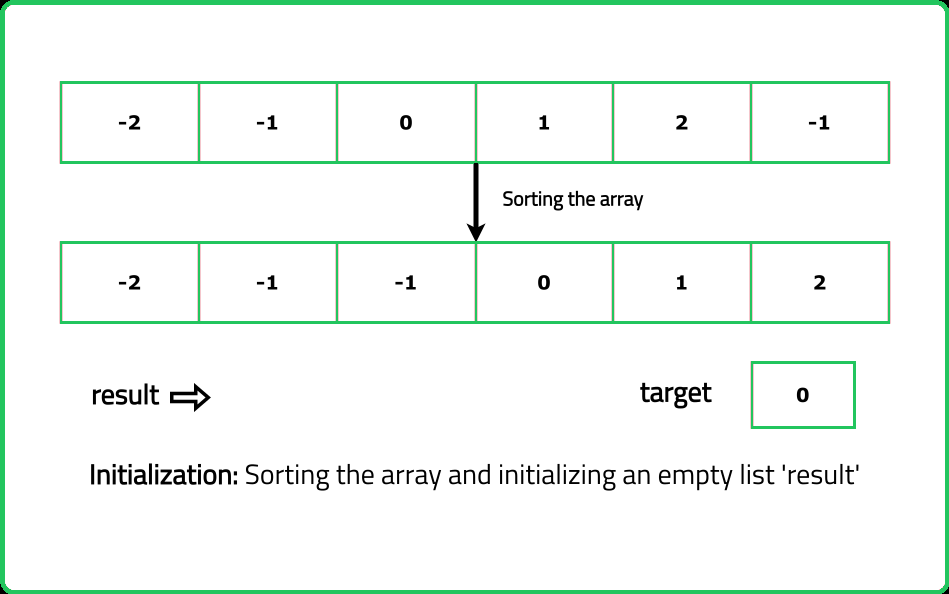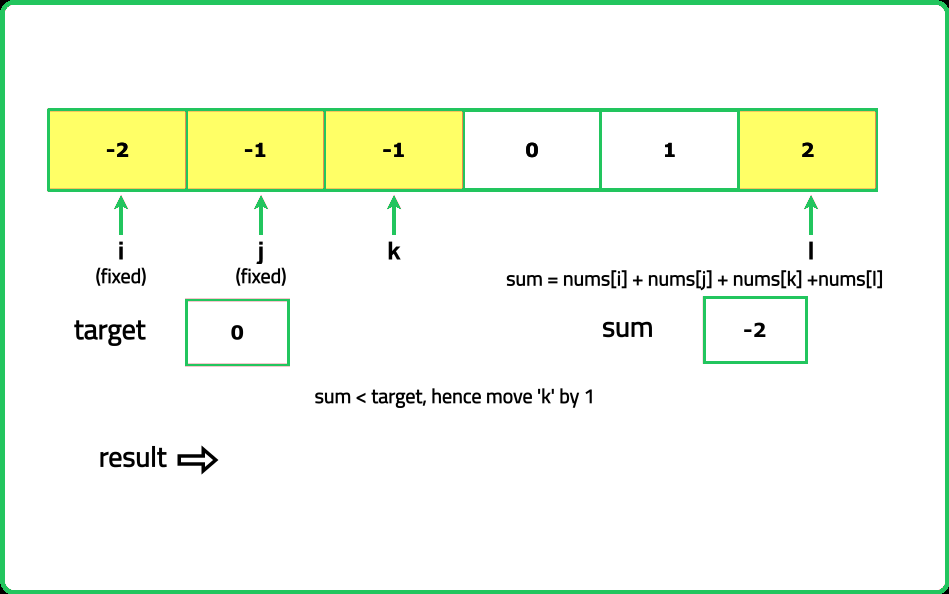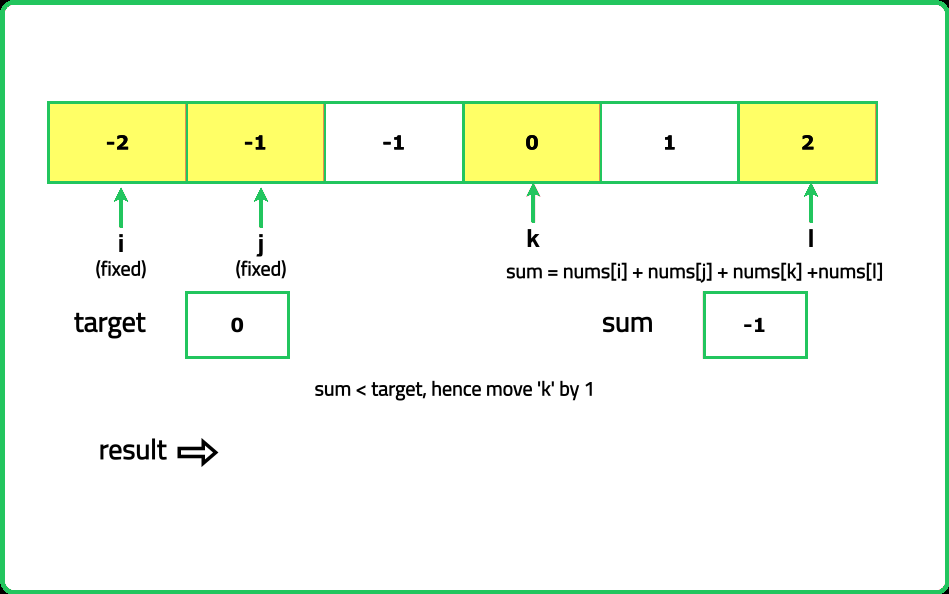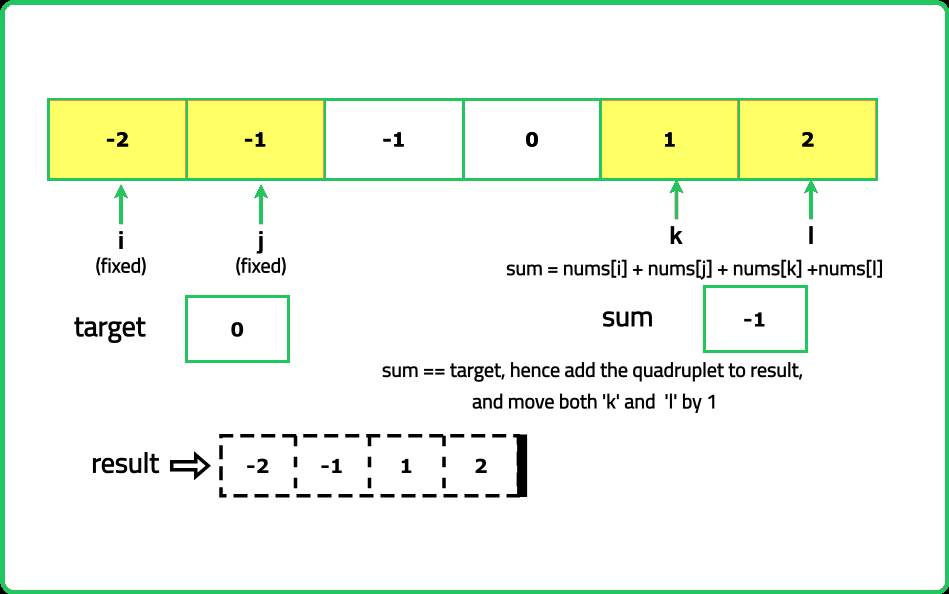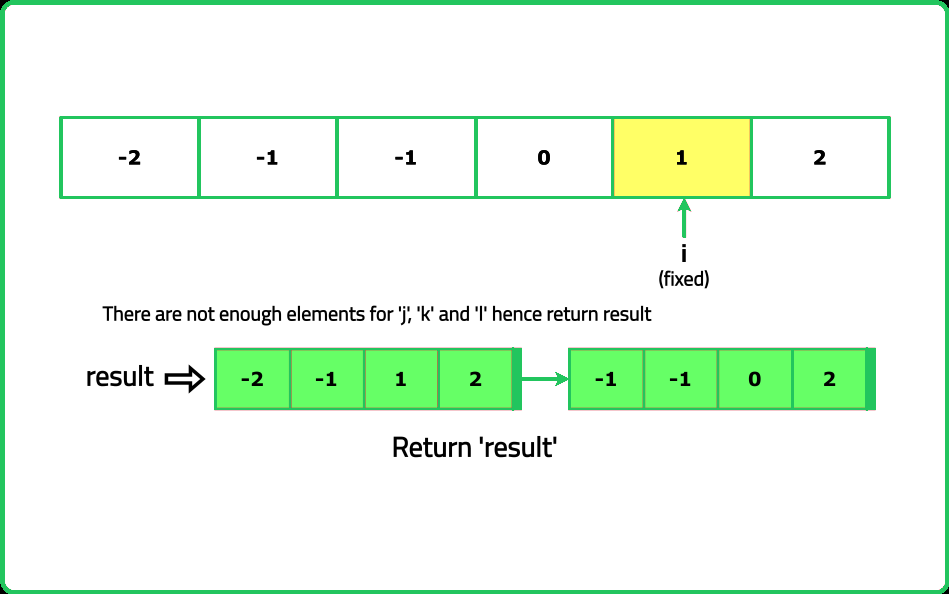12345678910111213141516171819202122232425262728293031323334353637383940414243444546474849505152535455565758596061
#include <bits/stdc++.h>
using namespace std;
class Solution {
public:
//function to find quadruplets having sum equal to target
vector<vector<int>> fourSum(vector<int>& nums, int target) {
// Size of the array
int n = nums.size();
// Set to store unique quadruplets
set<vector<int>> st;
// Checking all possible quadruplets
for (int i = 0; i < n; i++) {
for (int j = i + 1; j < n; j++) {
for (int k = j + 1; k < n; k++) {
for (int l = k + 1; l < n; l++) {
// Calculate the sum of the current quadruplet
long long sum = nums[i] + nums[j] + nums[k] + nums[l];
// Check if the sum matches the target
if (sum == target) {
vector<int> temp = {nums[i], nums[j], nums[k], nums[l]};
// Sort the quadruplet to ensure uniqueness
sort(temp.begin(), temp.end());
st.insert(temp);
}
}
}
}
}
// Convert set to vector (unique quadruplets)
vector<vector<int>> ans(st.begin(), st.end());
return ans;
}
};
int main() {
vector<int> nums = {4, 3, 3, 4, 4, 2, 1, 2, 1, 1};
int target = 9;
// Create an instance of Solution class
Solution sol;
vector<vector<int>> ans = sol.fourSum(nums, target);
// Print the result
cout << "The quadruplets are: \n";
for (auto& it : ans) {
cout << "[";
for (auto& ele : it) {
cout << ele << " ";
}
cout << "] ";
}
cout << "\n";
return 0;
}
1234567891011121314151617181920212223242526272829303132333435363738394041424344454647484950515253545556
import java.util.*;
class Solution {
//function to find quadruplets having sum equal to target
public List<List<Integer>> fourSum(int[] nums, int target) {
//size of the array
int n = nums.length;
// Set to store unique quadruplets
Set<List<Integer>> set = new HashSet<>();
// Checking all possible quadruplets
for (int i = 0; i < n; i++) {
for (int j = i + 1; j < n; j++) {
for (int k = j + 1; k < n; k++) {
for (int l = k + 1; l < n; l++) {
// Calculate the sum of the current quadruplet
long sum = nums[i] + nums[j] + nums[k] + nums[l];
// Check if the sum matches the target
if (sum == target) {
List<Integer> temp = Arrays.asList(nums[i], nums[j], nums[k], nums[l]);
// Sort the quadruplet to ensure uniqueness
Collections.sort(temp);
set.add(temp);
}
}
}
}
}
// Convert set to list (unique quadruplets)
return new ArrayList<>(set);
}
public static void main(String[] args) {
int[] nums = {4, 3, 3, 4, 4, 2, 1, 2, 1, 1};
int target = 9;
//create an instance of the Solution class
Solution sol = new Solution();
List<List<Integer>> ans = sol.fourSum(nums, target);
// Print the result
System.out.println("The quadruplets are: ");
for (List<Integer> quad : ans) {
System.out.print("[");
for (int num : quad) {
System.out.print(num + " ");
}
System.out.print("] ");
}
System.out.println();
}
}
1234567891011121314151617181920212223242526272829303132333435363738394041
from typing import List
class Solution:
#function to find quadruplets having sum equal to target
def fourSum(self, nums: List[int], target: int) -> List[List[int]]:
#size of array
n = len(nums)
#Set to store unique quadruplets
ans = set()
# Checking all possible quadruplets
for i in range(n):
for j in range(i + 1, n):
for k in range(j + 1, n):
for l in range(k + 1, n):
# Calculate the sum of the current quadruplet
sum_val = nums[i] + nums[j] + nums[k] + nums[l]
# Check if the sum matches the target
if sum_val == target:
temp = [nums[i], nums[j], nums[k], nums[l]]
# Sort the quadruplet to ensure uniqueness
temp.sort()
ans.add(tuple(temp))
return list(ans)
if __name__ == "__main__":
nums = [4, 3, 3, 4, 4, 2, 1, 2, 1, 1]
target = 9
#Create an instance of Solution class
sol = Solution()
ans = sol.fourSum(nums, target)
# Print the result
print("The quadruplets are: ")
for quad in ans:
print(f"[{', '.join(map(str, quad))}]")
123456789101112131415161718192021222324252627282930313233343536373839404142434445
class Solution {
// Function to find quadruplets with sum equal to target
fourSum(nums, target) {
const n = nums.length;
const resultSet = new Set();
// Checking all possible quadruplets
for (let i = 0; i < n; i++) {
for (let j = i + 1; j < n; j++) {
for (let k = j + 1; k < n; k++) {
for (let l = k + 1; l < n; l++) {
// Calculate the sum of the current quadruplet
const sum = nums[i] + nums[j] + nums[k] + nums[l];
// Check if the sum matches the target
if (sum === target) {
const temp = [nums[i], nums[j], nums[k], nums[l]];
// Sort the quadruplet to ensure uniqueness
temp.sort((a, b) => a - b);
resultSet.add(temp.join(',')); // Use join to store as unique string
}
}
}
}
}
// Convert set back to array of arrays (unique quadruplets)
const ans = Array.from(resultSet).map(item => item.split(',').map(Number));
return ans;
}
}
// Sample usage
const nums = [4, 3, 3, 4, 4, 2, 1, 2, 1, 1];
const target = 9;
// Create an instance of Solution class
const sol = new Solution();
const ans = sol.fourSum(nums, target);
// Print the result
console.log("The quadruplets are:");
ans.forEach(quadruplet => {
console.log(`[${quadruplet.join(' ')}]`);
});
